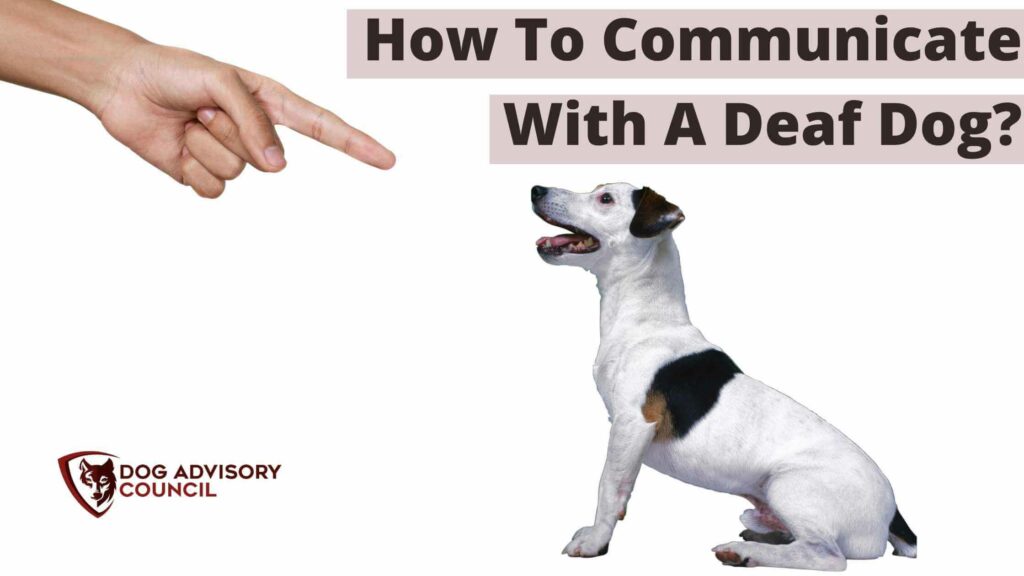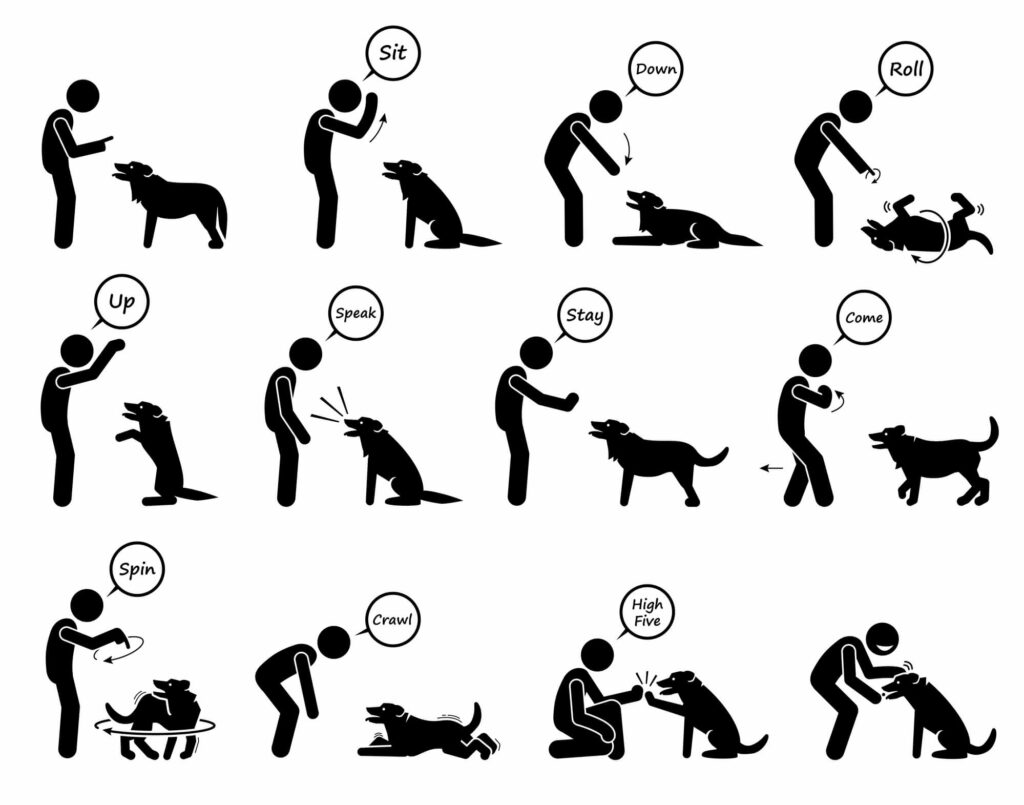
If your dog is deaf, you can still communicate with them just like a hearing dog. However, your methods will have to be a little different! Here’s all you should know on how to communicate with a deaf dog.
The best way to communicate with a deaf dog is through vibration. Tap on the floor or another surface that they can feel it through and use enough of a vibration to get their attention. When they feel it and look at you, add a hand signal to help them understand why you “called” them. You can also try flashlight training, leash tugging, rump tapping, and waving.
Below are more communication, discipline, and training suggestions to help you communicate effectively with your deaf dog.
How do you get the attention of a deaf dog?
When you are looking to get your dog’s attention, most just yell their name. This obviously doesn’t work if your dog is deaf! So, as introduced above, here are the main ways to get your dog’s attention:
- Stomp for vibrations
- Use a flashlight
- Try a leash tug
- Rely on the rump tap
- Give them a “pay attention” command
Stomp for vibrations
The most common way for owners to communicate with deaf dogs is to stomp or tap on something, which will cause a vibration that your dog can feel. You don’t need to jump up and down or knock sharply on anything. Just create enough of a vibration that your dog will sense it and respond by looking at you!
Looking at you is the goal of whatever approach you take since these methods replace calling your dog’s name.
Use a flashlight
Similar to how you would use a clicker for a hearing dog, a flashlight will become your go-to tool for a deaf dog. Use a small one that isn’t so bright it’ll hurt your dog’s eyes. Shine it at a location or your dog in a short pattern they’ll associate with paying attention.
Try a leash tug
If your dog is outside with you and on a leash, you can gently tug on the leash to get them to turn and look at you. Most find that 2 gentle tugs are enough to do just that. The emphasis is to pull gently on the leash in a pattern they recognize!
Rely on the rump tap
Whether on a leash or not, you can tap your dog’s rump to do the same thing. This is a great one for dogs that enjoy being touched, specifically. A light but firm tap on your dog’s rear end should be enough.
Remember to give them a “pay attention” command
Whatever choice feels right for you, ensure that you always follow it up with a command that you choose for “pay attention.” You don’t want to use one of these choices and then confuse your dog about why you did it.
Giving them a command directly after helps them to understand the attention-seeking motion is to deliberately get them to pay attention.
How do you call a deaf dog?
Using one of the methods above, you can combine it with a hand signal that they’ll learn to be their name. For example, instead of “pay attention,” you can make up a hand signal that means their name! This will replace it and also personalize it for your dog. Any command you give your dog should follow this hand signal for your dog’s name.
Can a deaf dog hear a dog whistle?
No, a dog can’t hear a dog whistle. If a dog is slowly losing its hearing instead of dealing with total deafness, it isn’t wise to rely on the whistle since your dog will more than likely lose the remainder of their hearing. At that point, the whistle will stop working, and it’ll cause confusion for your dog.
How do people communicate with deaf dogs?
The main communication with deaf dogs involves touch and physical motions. These could be as detailed as American Sign Language (ASL) or as simple as hand gestures that you make up. Your dog won’t know the difference, after all.
The other main communication method is direct eye contact! This is called “check-in” behavior, which we’ll discuss next. Deaf dogs have heightened senses in other areas, too, allowing them to use eye contact and sensation efficiently and effectively.
How do you train a deaf dog to look at you?
Getting your dog’s attention is going to be vital in getting them to listen to you (no pun intended). We talked about how to call your dog above using one of those methods, but is there a way to get your dog to look at you? Yes, actually. This is what we called check-in behavior above.
This is a routine or habit you can teach your dog using a flashlight or vibration communication method we mentioned earlier. Give them the prompt and then when they look at you (the end goal), use the flashlight to reward them or give them a treat. You’ll need to do this regularly, so they start to pair the action of looking at you with a reward.
Over time, your dog will start to check in by looking at you regularly to see if you need anything. You can stop flashing or treating when your dog gets the hang of it. Instead, you can use a command to get him to do something, show him one for “good boy,” or something similar.
Are vibration collars good for deaf dogs?
The above methods are recommended for deaf dogs since they have a higher success rate. However, you can consider a vibration collar if you’d prefer. These are specialized forms of collars that offer a gentle, slight vibration to get your dog’s attention.
They can be helpful for dog owners who want to use a handheld device to get their deaf dog’s attention, but make sure that you only use this if you’re committed to helping your dog understand what it is.
It can be very confusing for dogs, and many dogs are uncomfortable with it! If your dog is uncomfortable with it, don’t force them to wear it — find another way to communicate with them.
Can I use a vibrating collar for a deaf dog?
Before choosing a vibration collar for your dog, you’ll want to check with your vet. They’ll recommend brands and suggestions for introducing it to your dog for the best final effect.
If your vet doesn’t recommend one, for whatever reason, take their advice! They are the professionals, after all.
Is there a hearing aid for deaf dogs?
There is no such thing as a hearing aid for deaf dogs. They won’t understand what the hearing aids do (unlike humans, who will understand what’s happening), and dogs don’t often tolerate things in their ear, so they’ll simply shake them out.
Deaf dog hand signals chart
If you are looking for suggestions on what hand signals to use for a deaf dog to understand, you’ll want to create separate hand signals for each command (sit, stay, come, etc.).
These should be distinct enough that your dog can understand them and separate them from each other without difficulty. Of course, you’ll need to ensure that you remember them, too, so that you don’t send your dog mixed signals — literally!

How to discipline a deaf dog
It can be hard at first when you are looking specifically to discipline a deaf dog. Disciplining a hearing dog is often about body language with a tone of voice, but deaf dogs miss out on the second part of that.
When disciplining, training, and communicating, you’ll need to be consistent with your commands. You’ll want to use eye contact as your main method of communication. Pairing distinct signals and actions with eye contact will slowly teach your dog to understand what you need from them.
For example: If they’ve done something bad, you’ll want to signal “no” or “bad dog” and then direct them to a punishment of some sort. The signal that you choose should be paired consistently with the punishment (such as sitting in a corner or something) every time so that your dog starts to understand the punishment for what it is.
You’ll only want to use those commands and actions when your dog is actually in trouble; otherwise, it’ll confuse your dog!
If you can do so, consider adding a hearing dog to your training and disciplining routine. Pair a verbal command with a visual one; your deaf dog will match what your hearing dog does. It translates one language to the other and gives both dogs a companion! While this shouldn’t be the only reason you get a hearing dog, it is something to think about!
Can a clicker be used to train deaf dogs?
Unfortunately, a clicker can’t be used to train a deaf dog, as they won’t be able to hear it. This is why a flashlight is so often used for those who are fond of click training!
Tips for living with a deaf dog
If you’re still getting used to living with a deaf dog, take a moment to catch your breath. You’re doing great! It’s complicated and frustrating, and sometimes it’s easy to resent your dog’s deafness.
However, living with a deaf dog is an excellent opportunity to learn compassion for those with disabilities. It will also be great for helping your dog have a positive learning experience with their humans, even if they don’t understand everything quite as clearly!
When living with your deaf dog, you’ll want to be patient, first and foremost. Patient with your dog, but also with yourself. You’re both going through a steep learning curve, and it’ll be essential to acknowledge that for what it is.
When choosing the hand signals for your dog, you’ll want to pick ones everyone in your household understands and can physically do. After all, you won’t be the only one training and “talking” to your dog, so you’ll need to make commands that everyone can use to help bond with your dog.
One of the most important things about living with your deaf dog is understanding the importance of startle training. Deaf dogs are easily startled since they can’t hear the obvious signs of someone coming up to them, particularly when asleep.
You’ll need to startle-train them by waking them up regularly from sleep and then immediately treating them when they wake up. The goal is to pair startling with a positive thing, and they won’t fear it. With them, this should be done early on in your life for the best results.
Lastly, you’ll need to remember this important detail: never leave home without telling your dog. If your dog is asleep, wake them up gently and give them a command to let them know you are leaving. If you “disappear” on your dog while they are asleep, they can’t understand where you’ve gone or when you are coming back. Always let your dog know that you’re leaving!
In general
Communicating with a deaf dog is undoubtedly different than doing it with a traditional hearing dog, but there’s no reason that it can’t be a rewarding experience!
It is best done through vibration, touch, and the use of light. This will help get their attention, and then you can use hand signals to show them a command to pay attention and do whatever it is that you need them to do.
Communicating with a deaf dog is challenging and stressful at first, but it is a great learning experience for dog lovers! Make sure you know all the dos and don’ts of communicating with a deaf dog!
Know someone who will find this as fascinating as you did? Consider sharing this with them!
